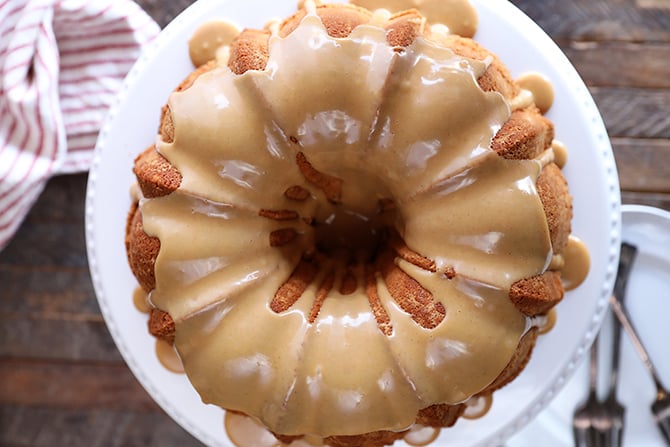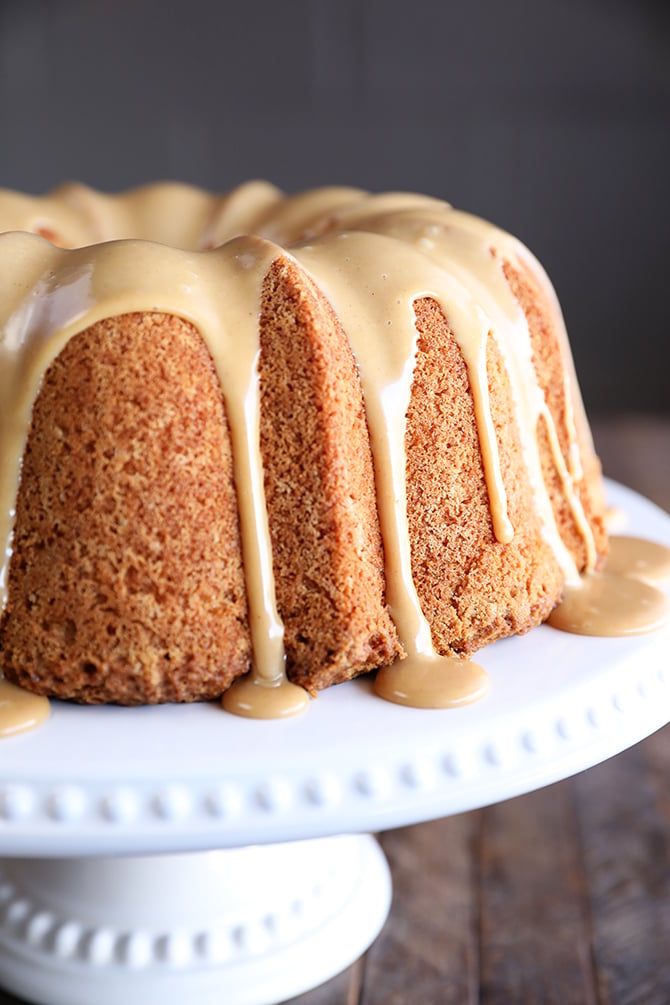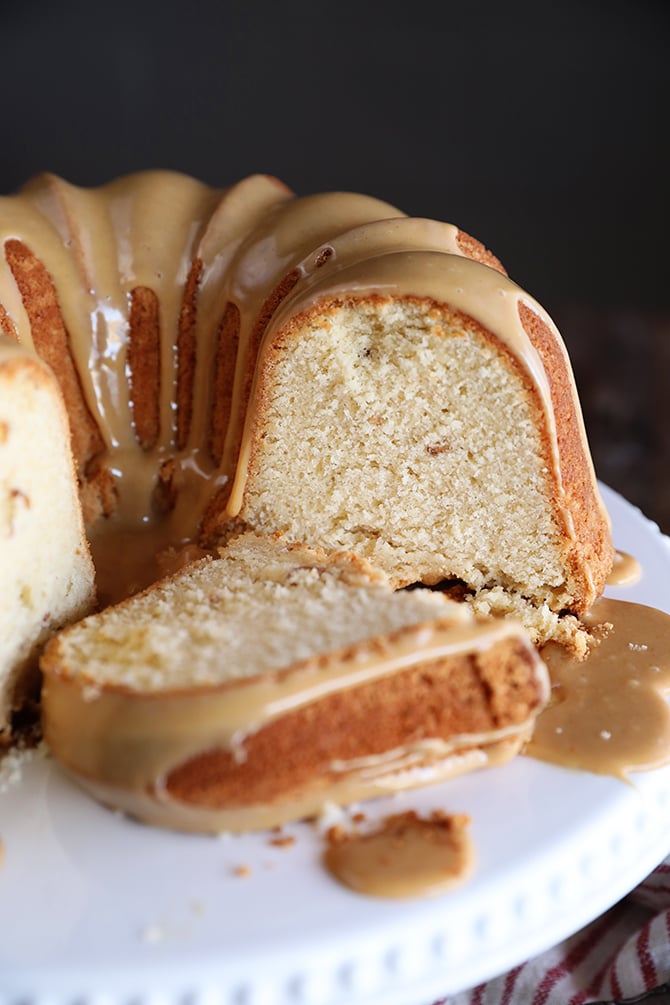Peanut Butter Cream Pound Cake
Posted by admin on
This recipe for Peanut Butter Cream Pound Cake makes a dense, moist pound cake with a crusty exterior that’s lightly flavored with peanut butter. It’s topped with a decadent peanut butter glaze made with sweetened condensed milk.

As part of my ongoing partnership with the Alabama Farmers Federation, I get to share some of the amazing recipes that have been featured in previous editions of their monthly magazine, Neighbors.
This month, I’m sharing this absolutely amazing Peanut Butter Cream Pound Cake from Lyn McDaniel. And when I say absolutely amazing… I mean it. I’m a big pound cake fan and this has to be one of my favorites!

To start, this cake is made with peanut butter. And as peanut butter is one of my most favorite things in the world, I was destined to like this from the get-go.
Next, the glaze on this dense, moist pound cake is made with more peanut butter and another favorite ingredient of mine… sweetened condensed milk. Seriously. It’s crazy delicious!
And while this recipe is super easy, I’ve got a few tips to make sure your pound cake turns out perfectly every single time.

Tips for the perfect pound cake:
Start with room temperature ingredients. Make sure your eggs and fat (in this case shortening, butter, and cream cheese) are at room temperature. A cake is an emulsion of ingredients and those ingredients are going to combine more easily and evenly when they’re all at the same temperature.
When it says to cream the fat and sugar, do it. Nearly every pound cake recipe is going to tell you to cream the fat and sugar together. This doesn’t just mean until it’s combined. You’ll want to mix in for about 5 minutes until the color has lightened and it’s fluffy. Yes, I’m serious. 4 to 5 minutes – depending on the speed of your mixer.
But don’t over-mix! I know what you’re saying… you just said mix it really well. Well, once you add the eggs and flour, you don’t want to over-mix the batter. You can end up with a cake that has a fragile crust and it can get dense, rubbery, and might even shrink when it comes out of the oven. So, to recap… mix the fat and sugar like crazy, but only mix it enough to combine once you add the eggs and flour.
Prep your pan the right way. I have some old school pans that rarely stick. Some of my newer pans are notorious for sticking. The one thing that always works for me is to coat the pan in vegetable shortening, like Crisco, and flour it – being sure to get all the little crevices. Sometimes the baking sprays with flour work, many times they don’t.
Don’t over fill your pan. Most pound cake recipes are formulated for a 12 cup bundt pan. The problem with that is that some of the newer, more decorative pans won’t hold that much. So, be sure not to overfill your pan or you’ll be scraping burn cake off the bottom of your oven. For a little insurance policy, you can always place a baking sheet on the oven rack below the cake to catch the overflow. It’s a lot easier to clean a pan than the oven.

There’s nothing worse than putting all that work into a pound cake to then find that it’s overcooked and dry. Likewise, you don’t want it to be undercooked either. Undercooked cakes can still be liquidy or they can seem fully cooked but still have a dense middle section that didn’t get cooked. Here are my tips for making sure your cake is cooked properly…
How to tell when your pound cake is done:
The sides pull away from the pan. This is a visual cue that your cake is nearing being done. The edges of the cake will start to pull away form the sides of the pan. This isn’t a foolproof method, but one of the cues I use.
A cake tester comes out clean. Use a toothpick or skewer to test the cakes doneness. When inserted in the center of the cake, it should come out with no signs of wet batter. If a few crumbs come out on the tester, that’s ok.
The cake temp is around 208° to 210°F. Yes, I use a use a kitchen thermometer to test my cake’s doneness. Inserted into the center of the cake, it should register above 200° but no more than 212°F. I shoot for the range between 208° and 210°F.
Again, none of these methods are foolproof all by themselves, but a combination of them should yield a perfectly cooked cake.


Peanut Butter Cream Pound Cake
Ingredients
For the cake:
- 1/2 cup butter flavored solid shortening
- 1 cup unsalted butter, softened
- 1 (8-ounce) package cream cheese, softened
- 1/2 cup crunchy peanut butter
- 3 cups sugar
- 6 eggs
- 3 cups all-purpose flour
- 2 teaspoons baking powder
- 1/8 teaspoon salt
- 2 teaspoons vanilla extract
For the glaze icing:
- 3/4 cup sweetened condensed milk
- 1/2 cup peanut butter
- 3 tablespoons milk
Instructions
- Grease and flour a 12-cup bundt pan. Set aside. DO NOT preheat the oven.
- In a large bowl, use a mixer to cream shortening, butter, cream cheese, and peanut butter until smooth. Gradually add the sugar, beating until light and fluffy. Add eggs one at a time, beating well after each.
- In a small bowl, whisk together the flour, baking powder, and salt. Gradually add the flour mixture to the creamed mixture, blending well. Add the vanilla and mix well.
- Pour into the prepared pan. Place in a cold oven. Bake at 325°F for 1 hour and 15 minutes or until toothpick inserted in the center of the cake comes out clean. Allow to rest in the pan for about 10 minutes, then invert onto a serving platter.
- Make the glaze icing by mixing the sweetened condensed milk, peanut butter, and milk together until smooth. Pour over cooled cake.
The post Peanut Butter Cream Pound Cake appeared first on Southern Bite.
